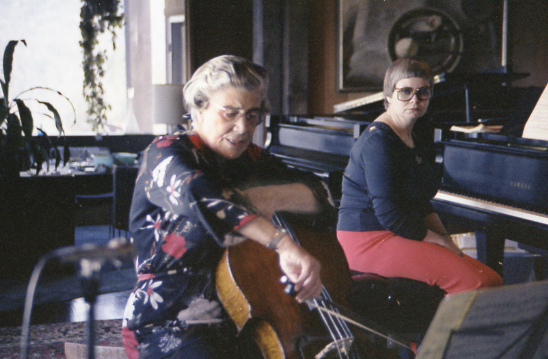
Remembering a Great Teacher
The memory of my first meeting with Margaret Rowell never fails to bring a smile to my face.
.jpg)
Margaret Rowell in the early 1980s (photo by Carol Wright)
A cellist had invited me to play the Brahms E Minor sonata with him. Having recently transferred to the San Francisco Conservatory as a student and eager to establish my performing cred with the community, I quickly acquiesced and began rehearsing.
Not too long afterwards my cellist had arranged to play the sonata in his teacher’s weekly studio class. (For those of you who aren’t familiar with the inner workings of a conservatory: each studio teacher sets up a weekly time when all of that teacher’s students will meet together. Often called “rep class” or “studio class”, this is in addition to the one-on-one weekly private lesson that forms the backbone of traditional musical education.)
At the time I was not particularly well acquainted with the cello world and so the name “Margaret Rowell” failed to ring any bells. I knew that she was one of the SF Conservatory’s three cello teachers (the others being Bonnie Hampton and Irene Sharp). I was unaware that Margaret was, in fact, one of the most beloved and respected tribal elders amongst the world’s great cello teachers.
But I quickly discovered the personal alchemy that made her such a great teacher. At Margaret’s studio class, my cellist introduced me to Margaret and to the assembly of Rowell students, then he and I played the first movement of the Brahms. It went well enough, as I recall.
Margaret began by addressing me, rather than her student, typical (as I was to learn) for her, in that she would always welcome newcomers and ensure that they felt comfortable and accepted.
She beamed at me, her wise eyes twinkling. “You like Brahms, don’t you?” she chirped to me. “Oh, yes,” I replied: “I like Brahms very much.”
She leaned forward just a bit on her chair and lowered her voice to a near-whisper, speaking almost as if sharing a cherished secret with me (albeit right in front of the whole room). “I like Brahms, too!” she said, nodding her head in happy agreement and positively glowing with warmth.
I fell in love with her on the spot and from that moment on Margaret Rowell was to serve in my musical life as a recurring source of inspiration, an inexhaustible role model, and eventually a dearly-loved colleague. I accompanied any number of her students over the years. Some of them have, alas, blurred in my memory, but Margaret herself remains vivid in my mind. She was rigorous, enthusiastic, incredibly strong and forthright in her opinions and methods. Oh, she could lay into a dilatory kid with all the fire of a revivalist preacher confronting a habitual sinner, but only if strictly necessary. Generally speaking her modus operandi consisted of roughly equal parts of infectious enthusiasm, bottomless knowledge, laser-sharp concentration, and an all-encompassing love for her students and their dedication to music. I met her when she was in her late sixties; she continued to teach for several more decades without noticeable flagging of that astonishing stamina and heady delight.
She could make you play better just by looking at you. She could also make you play better by working you tirelessly until you were frustrated and exhausted and confused and mortally convinced that everything you were doing was impossibly wrong. Her techniques have become legendary, especially the “hug” -- a treatment of the arms and back that is just as beneficial for pianists as for cellists.

The Hug: Margaret Rowell (photo by Carol Wright)
All musicians like to swap stories of their teachers, talking of the demanding Herr X or the frightening Monsieur Y or the capricious Madame Z. I’ve had my share of hysterics, lackadaisies, and tinpot Hitlers. I’ve also had my cherished mentors, friends, and guides.
But there wasn’t anyone quite like Margaret Rowell, even if she wasn’t my teacher per se (pianists don’t study with cello teachers as a rule.) Possibly her lasting legacy to me remains her absolute freedom in expressing her love of music. She was never oh-so-professional and businesslike about music, playing the cello, or teaching others to make music. Margaret had fun teaching the cello. She had fun talking about music and listening to people play and schmoozing about music with her colleagues. She had fun watching her students grow and develop.
And we had wonderful fun being her students and colleagues.
Margaret Avery Rowell was born in Redlands, California in 1900 and died on April 21, 1995 in Berkeley. You may read her obituary in the New York Times here, and this beautiful reminiscence by her student and colleague Irene Sharp here.
